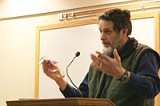[
{
"name": "500x250 Ad",
"insertPoint": "5",
"component": "15667920",
"parentWrapperClass": "",
"requiredCountToDisplay": "1"
}
]
Thirty years ago, people driving to Rochester from the south would have seen a landscape of mainly farms, fields, and woods.
Now, most of that bucolic countryside is little more than a memory, replaced by shopping malls, tract housing, and the odd mix of commercial accretion that follows suburbia.
US Census Bureau data shows that housing construction continues to outpace population growth locally. From 1990 to 2000 MonroeCounty's population grew by 3 percent. Its housing stock, however, rose 6.6 percent.
Some suburbs have started to recognize trends like that and take action with smarter planning measures. But as growth of all kinds continues unabated, those measures are starting to be tested, their relevance at stake.
A development plan in Pittsford is a prime example of the conflict between property rights and the public's stake in the landscape. On a parcel just northwest of MendonPondsPark, a local developer is planning a subdivision with almost 100 houses. Opponents of the plan have attacked nearly every element of the plan, from lighting and the potential impact on local aquifers to the changes the development would make to the area's rural character.
The way developer Chuck Ryan sees it, he's simply a businessman meeting a proven demand --- in this case, demand for new housing by aging baby boomers.
"The market we're in is empty-nesters, due to the demographics," says Ryan. "People 55 and older are the fastest growing segment of the population. We've gotten a tremendous demand from people who want to stay in the town of Pittsford or stay on the southeast side of town that want to downsize, but still would like their own lot and like their own house but just want a smaller piece of property or smaller house to live in. Most of them want a master bedroom on the first floor. Their children are usually grown. They've come from a big house. They've lived in the community a long time, would like to stay in the community."
Ryan has already built other subdivisions targeted at this market, and now he has waiting lists of people who want such lots.
To fill that demand, Ryan plans to buy a 115-acre tract known as the Young Farm and build 92 houses on it. The property straddles Clover Street, just north of the Canfield Road entrance to MendonPondsPark.
It's also in a unique strip that Pittsford has zoned as "Rural Residential South Pittsford."
When they build in that district --- all of Pittsford south of the New York State Thruway --- developers must meet special requirements. Those requirements were added to town zoning law last April in the wake of a temporary moratorium on construction in that area.
During the moratorium, the Town of Pittsford took stock of its undeveloped land and decided to adopt more stringent measures in the new zoning district. The idea was to conserve things like "rural character, agriculture, open space lands, and visual and wildlife buffer area adjacent to MendonPondsPark lands," according to the text of the local law.
To meet the twin goals of preserving those values and still allowing development, the town settled on 10 criteria for developments larger than 20 acres. Those criteria operate as a sliding scale, determining the density of housing permitted.
"If a developer met eight of the 10, he could have X number of units," explains Bill Brizee. "If he could only meet six of these criteria, then he'd have a less number of houses allowed." As chair of the Pittsford Town Planning Board, Brizee has the sometimes thankless task of implementing the criteria in a way that balances public interest with the property rights of individual developers and landowners. The idea, he says, is that "if you do a good enough job in design --- if you meet these criteria --- then you can build it."
If only determining whether a specific development met the criteria were as easy as it sounds. True, some of the criteria, like Number 6 --- "provision of public sewers" --- seem to leave little room for interpretation. But others, like Numbers 1 and 9 --- "preservation of agricultural lands and uses" and "design that respects and buffers MendonPondsPark" --- are anything but specific.
Does a vegetable garden constitute "agricultural use?" How big a buffer is buffer enough? The law doesn't say.
"This is somewhat difficult zoning, in that it's interpretation," says Brizee. "There's a little bit of subjectiveness in meeting the zoning requirements of these 10 items. Other zoning things are more clear cut."
Indeed. Ryan --- who is now seeking the first of three approvals from the town planning board ---says he believes his plans solidly meet nine of the 10 criteria. (The one he says he's "fuzzy" on is farmland preservation, since a historic barn would be sold off.) To make certain he meets the town's new guidelines, Ryan's hired a prominent designer, and says most of the design changes he's made are positive ones.
Take the density planned houses, for example. Each home will be built on about one third of an acre. That leaves about 65 percent of the total acreage as open space, says Ryan.
"With that amount of open space, they will be clustered," he says. "That's the only way to achieve that type of open space. You can't have large lots and preserve a lot of contiguous open space. You have to put the open space in large lots or do smaller lots and have large volumes of contiguous open space for the enjoyment of everybody. And that's what we were trying to do."
Critics complain that the lots are still spread along roads that sprawl themselves, turning the preserved open space (which will be handed over to the town) into tax-free back yards for the scaled down lots.
While Ryan believes he's fulfilled all or most of the town's new criteria, an informal opposition group calling itself Citizens for Rural South Pittsford says the proposal fails to meet nine out of the 10.
The group formed specifically out of concern over Ryan's subdivision plan. Some of C4RSP (as they abbreviate themselves) want the proposal killed, says Mary Scheuerman, one of the members. But she and others like her are more interested in making sure adequate study is conducted on the tract's impacts.
"If SEQR [the State Environmental Quality Review process] is followed and if the proper analysis is done, that will answer the question of will there be harm to the park and will there be harm to the character of the area," she says.
The concern over the area's rural character is heightened by the fact that parts of the east parcel abut MendonPondsPark.
"It's really not just a Pittsford issue," Scheuerman says. "It's a MonroeCounty issue, because lots of people use that park. They're the people that get cheated when a park gets compromised or damaged."
The development's proximity to the park has also sparked the interest of the Sierra Club's Rochester Regional Group.
"People should have an area where they can experience nature and have the benefit of it," says Frank Regan, one of the group's co-chairs.
"If the public knew there was any kind of threat," he says, "I would think it would be on their radar. I think they'd be alarmed."
In the standoff over whether the 10 criteria have been met, the planning board decided not to make a decision right away. Instead of ruling directly, they forwarded Ryan's plans to consultant John Behan, a planner who helped the town construct its "greenprint" (a town-wide open-space preservation priority plan) almost a decade ago, and more recently helped write the new zoning law for the land south of the Thruway. Behan responded with a memo that the planning board released at its meeting Monday night. That memo parses the Ryan plan one criterion at a time, saying some are met while others not.
In all but one case, the memo also recommends changes to the existing plan that would allow it to conform to the criteria. That criterion is the "preservation of agricultural land and uses," about which Behan writes: "We cannot envision any minor or moderate changes to the proposed plan to possibly achieve this criterion in a significant way."
And when it comes to preserving open space and protecting public views, Behan recommends removing a road on the west side, which has about a dozen homes on it in the Ryan plan. Chairman Bill Brizee says he believes that Ryan and the town can still come up with an acceptable plan. So for the moment, the board is taking no action on the plan, and the public hearing remains open. Though clearly frustrated by what has turned into a multi-year planning phase for the project, Ryan seemed optimistic leaving the meeting. "I think we're close," he said.
Whether the changes will appease the project's critics is unclear. The Sierra Club's other co-chair, Hugh Mitchell, is also conservation chair for the statewide Sierra chapter. Speaking to the planning board on Monday, Mitchell spoke to broader issues of sprawl and the preservation of rural character.
"Our concern is that this type of development --- loss of farmland and development of housing ---has a great deal of impact both on the city and on open space," he said.
So far, the development's critics have raised a broad variety of concerns, including some very technical ones relating the SEQR process.
But perhaps the most direct and honest apprehension came from a resident unconnected with C4RSP.
"This just seems out of place," Frank Bove told the board. "This doesn't seem like the kind of residential development I would expect in this part of the town. There are other places where it would fit in very nicely. But you're in an extremely rural area. This doesn't sound like the right kind of thing to do here."
That may seem to echo the town's intent in changing the zoning: to conserve "rural character." But what exactly constitutes "rural character" may be as open to interpretation as the town's zoning criteria.
"People always use the term 'Well, we're going to change the character of the neighborhood,'" says Ryan. "That's true. We are. We're going to change it for the better."
Speaking of Pittsford, suburban Development
-

Pittsford village moves to hold a vote on welcoming weed shops
Oct 25, 2021 -

Calendar preview: Adieu, August
Aug 26, 2020 -

Calendar preview: Summer stretch
Aug 5, 2020 - More »
Latest in News
More by Krestia DeGeorge
-

The last wild Finger Lakes
Jan 17, 2007 -

Designers get their turn at downtown
Jan 17, 2007 -

From the new governor: fighting words
Jan 10, 2007 - More »






